(265) Start a Biofertilizer Manufaturing Unit

Biofertilizers are defined as preparations containing living cells or latent cells of efficient strains of microorganisms that help crop plants’ uptake of nutrients by their interactions in the rhizosphere when applied through seed or soil. They accelerate certain microbial processes in the soil which augment the extent of availability of nutrients in a form easily assimilated by plants.
Very often microorganisms are not as efficient in natural surroundings as one would expect them to be and therefore artificially multiplied cultures of efficient selected microorganisms play a vital role in accelerating the microbial processes in soil.
Use of biofertilizers is one of the important components of integrated nutrient management, as they are cost effective and renewable source of plant nutrients to supplement the chemical fertilizers for sustainable agriculture. Several microorganisms and their association with crop plants are being exploited in the production of biofertilizers. They can be grouped in different ways based on their nature and function.
| S. No. | Groups | Examples |
N2 fixing Biofertilizers | ||
| 1. | Free-living | Azotobacter, Beijerinkia, Clostridium, Klebsiella, Anabaena, Nostoc, |
| 2. | Symbiotic | Rhizobium, Frankia, Anabaena azollae |
| 3. | Associative Symbiotic | Azospirillum |
P Solubilizing Biofertilizers | ||
| 1. | Bacteria | Bacillus megaterium var. phosphaticum, Bacillus subtilis Bacillus circulans, Pseudomonas striata |
| 2. | Fungi | Penicillium sp, Aspergillus awamori |
P Mobilizing Biofertilizers | ||
| 1. | Arbuscular mycorrhiza | Glomus sp.,Gigaspora sp.,Acaulospora sp., Scutellospora sp. & Sclerocystis sp. |
| 2. | Ectomycorrhiza | Laccaria sp., Pisolithus sp., Boletus sp., Amanita sp. |
| 3. | Ericoid mycorrhizae | Pezizella ericae |
| 4. | Orchid mycorrhiza | Rhizoctonia solani |
Biofertilizers for Micro nutrients | ||
1. | Silicate and Zinc solubilizers | Bacillus sp. |
Plant Growth Promoting Rhizobacteria | ||
1. | Pseudomonas | Pseudomonas fluorescens |
Rhizobium

Rhizobium is a soil habitat bacterium, which can able to colonize the legume roots and fixes the atmospheric nitrogen symbiotically. The morphology and physiology of Rhizobium will vary from free-living condition to the bacteroid of nodules. They are the most efficient biofertilizer as per the quantity of nitrogen fixed concerned. They have seven genera and highly specific to form nodule in legumes, referred as cross inoculation group. Rhizobium inoculant was first made in USA and commercialized by private enterprise in 1930s and the strange situation at that time has been chronicled by Fred (1932).
Initially, due to absence of efficient bradyrhizobial strains in soil, soybean inoculation at that time resulted in bumper crops but incessant inoculation during the last four decades by US farmers has resulted in the build up of a plethora of inefficient strains in soil whose replacement by efficient strains of bradyrhizobia has become an insurmountable problem.
Azotobacter
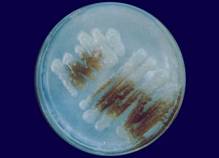
Of the several species of Azotobacter, A. chroococcum happens to be the dominant inhabitant in arable soils capable of fixing N2 (2-15 mg N2 fixed /g of carbon source) in culture media. The bacterium produces abundant slime which helps in soil aggregation. The numbers of A. chroococcum in Indian soils rarely exceeds 105/g soil due to lack of organic matter and the presence of antagonistic microorganisms in soil.
Azospirillum

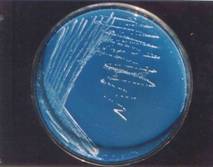
Azospirillum lipoferum and A. brasilense (Spirillum lipoferum in earlier literature) are primary inhabitants of soil, the rhizosphere and intercellular spaces of root cortex of graminaceous plants. They perform the associative symbiotic relation with the graminaceous plants. The bacteria of Genus Azospirillum are N2 fixing organisms isolated from the root and above ground parts of a variety of crop plants. They are Gram negative, Vibrio or Spirillum having abundant accumulation of polybetahydroxybutyrate (70 %) in cytoplasm.
Five species of Azospirillum have been described to date A. brasilense, A.lipoferum, A.amazonense,A.halopraeferens and A.irakense. The organism proliferates under both anaerobic and aerobic conditions but it is preferentially micro-aerophilic in the presence or absence of combined nitrogen in the medium. Apart from nitrogen fixation, growth promoting substance production (IAA), disease resistance and drought tolerance are some of the additional benefits due to Azospirillum inoculation.
Cyanobacteria

Both free-living as well as symbiotic cyanobacteria (blue green algae) have been harnessed in rice cultivation in India. A composite culture of BGA having heterocystous Nostoc, Anabaena, Aulosira etc. is given as primary inoculum in trays, polythene lined pots and later mass multiplied in the field for application as soil based flakes to the rice growing field at the rate of 10 kg/ha. The final product is not free from extraneous contaminants and not very often monitored for checking the presence of desiredalgal flora.
Once so much publicized as a biofertilizer for the rice crop, it has not presently attracted the attention of rice growers all over India except pockets in the Southern States, notably Tamil Nadu. The benefits due to algalization could be to the extent of 20-30 kg N/ha under ideal conditions but the labour oriented methodology for the preparation of BGA biofertilizer is in itself a limitation. Quality control measures are not usually followed except perhaps for random checking for the presence of desired species qualitatively.
Azolla
Azolla is a free-floating water fern that floats in water and fixes atmospheric nitrogen in association with nitrogen fixing blue green alga Anabaena azollae. Azolla fronds consist of sporophyte with a floating rhizome and small overlapping bi-lobed leaves and roots. Rice growing areas in South East Asia and other third World countries have recently been evincing increased interest in the use of the symbiotic N2 fixing water fern Azolla either as an alternate nitrogen sources or as a supplement to commercial nitrogen fertilizers. Azolla is used as biofertilizer for wetland rice and it is known to contribute 40-60 kg N/ha per rice crop.
Phosphate solubilizing microorganisms(PSM)
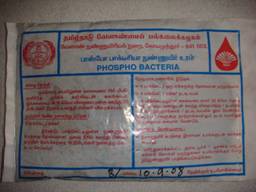
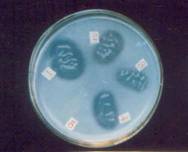
Several soil bacteria and fungi, notably species of Pseudomonas, Bacillus, Penicillium, Aspergillus etc. secrete organic acids and lower the pH in their vicinity to bring about dissolution of bound phosphates in soil. Increased yields of wheat and potato were demonstrated due to inoculation of peat based cultures of Bacillus polymyxa and Pseudomonas striata. Currently, phosphate solubilizers are manufactured by agricultural universities and some private enterprises and sold to farmers through governmental agencies. These appear to be no check on either the quality of the inoculants marketed in India or the establishment of the desired organisms in the rhizosphere.
AM fungi
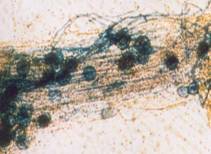
The transfer of nutrients mainly phosphorus and also zinc and sulphur from the soilmilleu to the cells of the root cortex is mediated by intracellular obligate fungal endosymbionts of the genera Glomus, Gigaspora, Acaulospora, Sclerocysts and Endogone which possess vesicles for storage of nutrients and arbuscles for funneling these nutrients into the root system. By far, the commonest genus appears to be Glomus, which has several species distributed in soil. Availability for pure cultures of AM (Arbuscular Mycorrhiza) fungi is an impediment in large scale production despite the fact that beneficial effects of AM fungal inoculation to plants have been repeatedly shown under experimental conditions in the laboratory especially in conjunction with other nitrogen fixers.
Silicate solubilizing bacteria (SSB)
Silicate solubilizing bacteria (SSB)
Microorganisms are capable of degrading silicates and aluminum silicates. During the metabolism of microbes several organic acids are produced and these have a dual role in silicate weathering. They supply H+ ions to the medium and promote hydrolysis and the organic acids like citric, oxalic acid, Keto acids and hydroxy carbolic acids which from complexes with cations, promote their removal and retention in the medium in a dissolved state.
The studies conducted with a Bacillus sp. isolated from the soil of granite crusher yard showed that the bacterium is capable of dissolving several silicate minerals under in vitro condition. The examination of anthrpogenic materials like cement, agro inputs like super phosphate and rock phosphate exhibited silicate solubilizing bacteria to a varying degree. The bacterial isolates made from different locations had varying degree of silicate solubilizing potential. Soil inoculation studies with selected isolate with red soil, clay soil, sand and hilly soil showed that the organisms multiplied in all types of soil and released more of silica and the available silica increased in soil and water. Rice responded well to application of organic sliceous residue like rice straw, rice husk and black ash @ 5 t/ha. Combining SSB with these residues further resulted in increased plant growth and grain yield. This enhancement is due to increased dissolution of silica and nutrients from the soil.
Plant Growth Promoting Rhizobacteria (PGPR)
The group of bacteria that colonize roots or rhizosphere soil and beneficial to crops are referred to as plant growth promoting rhizobacteria (PGPR).
The PGPR inoculants currently commercialized that seem to promote growth through at least one mechanism; suppression of plant disease (termed Bioprotectants), improved nutrient acquisition (termed Biofertilizers), or phytohormone production (termed Biostimulants). Species of Pseudomonas and Bacillus can produce as yet not well characterized phytohormones or growth regulators that cause crops to have greater amounts of fine roots which have the effect of increasing the absorptive surface of plant roots for uptake of water and nutrients. These PGPR are referred to as Biostimulants and the phytohormones they produce include indole-acetic acid, cytokinins, gibberellins and inhibitors of ethylene production.
Recent advances in molecular techniques also are encouraging in that tools are becoming available to determine the mechanism by which crop performance is improved using PGPR and track survival and activity of PGPR organisms in soil and roots. The science of PGPR is at the stage where genetically modified PGPR can be produced. PGPR with antibiotic, phytohormone and siderophore production can be made.
Despite of promising results, biofertilizers has not got widespread application in agriculture mainly because of the variable response of plant species or genotypes to inoculation depending on the bacterial strain used. Differential rhizosphere effect of crops in harbouring a target strain or even the modulation of the bacterial nitrogen fixing and phosphate solubilizing capacity by specific root exudates may account for the observed differences. On the other hand, good competitive ability and high saprophytic competence are the major factors determining the success of a bacterial strain as an inoculant.
Studies to know the synergistic activities and persistence of specific microbial populations in complex environments, such as the rhizosphere, should be addressed in order to obtain efficient inoculants. In this regards, research efforts are made at Agricultural College and Research Institute, Madurai to obtain appropriate formulations of microbial inoculants incorporating nitrogen fixing, phosphate- and silicate- solubilizing bacteria and plant growth promoting rhizobacteria which will help in promoting the use of such beneficial bacteria in sustainable agriculture.
Liquid Biofertilizers

Biofertilizers are such as Rhizobium, Azospirillum and Phosphobacteria provide nitrogen and phosphorous nutrients to crop plants through nitrogen fixation and phosphorous solubilization processes. These Biofertilizers could be effectively utilized for rice, pulses, millets, cotton, sugarcane, vegetable and other horticulture crops. Biofertilizers is one of the prime input in organic farming not only enhances the crop growth and yield but also improves the soil health and sustain soil fertility. At present, Biofertilizers are supplied to the farmers as carrier based inoculants. As an alternative, liquid formulation technology has been developed in the Department of Agricultural Microbiology, TNAU, Coimbatore which has more advantages than the carrier inoculants.
Benefits
The advantages of Liquid Bio-fertilizer over conventional carrier based Bio-fertilizers are listed below:
The advantages of Liquid Bio-fertilizer over conventional carrier based Bio-fertilizers are listed below:
- Longer shelf life -12-24 months.
- No contamination.
- No loss of properties due to storage upto 45º c.
- Greater potentials to fight with native population.
- High populations can be maintained more than 109 cells/ml upto 12 months to 24 months.
- Easy identification by typical fermented smell.
- Cost saving on carrier material, pulverization, neutralization, sterilization, packing and transport.
- Quality control protocols are easy and quick.
- Better survival on seeds and soil.
- No need of running Bio-fertilizer production units through out the year.
- Very much easy to use by the farmer.
- Dosages is 10 time less than carrier based powder Bio-fertilizers.
- High commercial revenues.
- High export potential.
- Very high enzymatic activity since contamination is nil.
Rhizobium
This belongs to bacterial group and the classical example is symbiotic nitrogen fixation. The bacteria infect the legume root and form root nodules within which they reduce molecular nitrogen to ammonia which is reality utilized by the plant to produce valuable proteins, vitamins and other nitrogen containing compounds. The site of symbiosis is within the root nodules. It has been estimated that 40-250 kg N / ha / year is fixed by different legume crops by the microbial activities of Rhizobium. The percentage of nodules occupied, nodules dry weight, plant dry weight and the grain yield per plant the multistrain inoculant was highly promising Table-2 shows the N fixation rates.
Quantity of biological N fixed by Liqiud Rhizobium in different crops
Host Group | Rhizobium Species | Crops | N fix kg/ha |
Pea group | Rhizobium leguminosarum | Green pea, Lentil | 62- 132 |
Soybean group | R.japonicum | Soybean | 57- 105 |
Lupini Group | R. lupine orinthopus | Lupinus | 70- 90 |
Alfafa grp.Group | R.mellilotiMedicago Trigonella | Melilotus | 100- 150 |
Beans group | R. phaseoli | Phaseoli | 80- 110 |
Clover group | R. trifoli | Trifolium | 130 |
Cowpea group | R. species | Moong, Redgram, Cowpea, Groundnut | 57- 105 |
Cicer group | R. species | Bengal gram | 75- 117 |
Physical features of liquid Rhizobium
- Dull white in colour
- No bad smell
- No foam formation, pH 6.8-7.5
It belongs to bacteria and is known to fix the considerable quantity of nitrogen in the range of 20- 40 kg N/ha in the rhizosphere in non- non-leguminous plants such as cereals, millets, Oilseeds, cotton etc. The efficiency ofAzospirillium as a Bio-Fertilizer has increased because of its ability of inducing abundant roots in several pants like rice, millets and oilseeds even in upland conditions. Considerable quantity of nitrogen fertilizer up to 25-30 % can be saved by the use of Azospirillum inoculant. The genus Azospirillum has three species viz., A. lipoferum, A. brasilense and A. amazonense. These species have been commercially exploited for the use as nitrogen supplying Bio-Fertilizers.
One of the characteristics of Azospirillum is its ability to reduce nitrate and denitrify. Both A. lipoferum,and A. brasilense may comprise of strains which can actively or weakly denitrify or reduce nitrate to nitrite and therefore, for inoculation preparation, it is necessary to select strains which do not possess these characteristics. Azospirllium lipoferum present in the roots of some of tropical forage grasses uch as Digitaria, Panicum, Brachiaria, Maize, Sorghum, Wheat and Rye.
Physical features of liquid Azospirillum
- The colour of the liquid may be blue or dull white.
- Bad odours confirms improper liquid formulation and may be concluded as mere broth.
- Production of yellow gummy colour materials comfirms the quality product.
- Acidic pH always confirms that there is no Azospirillum bacteria in the liquid.
Plant | Mg N2 fixed /g of substrate |
| Oryza sativa (Paddy) | 28 |
| Sorghum bicolour (Sorghum) | 20 |
| Zea mays (Maize) | 20 |
| Panicum sp. | 24 |
| Cynodon dactylon | 36 |
| Setaria sp | 12 |
| Amaranthus spinosa | 16 |
Production of growth hormones
Azospirillum cultures synthesize considerable amount of biologically active substances like vitamins, nicotinic acid, indole acetic acids giberllins. All these hormones/chemicals helps the plants in better germination, early emergence, better root development.
Role of Liquid Azospirillum under field conditions
- Stimulates growth and imparts green colour which is a characteristic of a healthy plant.
- Aids utilization of potash, phosphorous and other nutrients.
- Encourage plumpness and succulence of fruits and increase protein percentage.
Sign of non functioning of Azospirillum in the field
- No growth promotion activity
- Yellowish green colour of leaves, which indicates no fixation of Nitrogen
Azotobacter
It is the important and well known free living nitrogen fixing aerobic bacterium. It is used as a Bio-Fertilizer for all non leguminous plants especially rice, cotton, vegetables etc. Azotobacter cells are not present on the rhizosplane but are abundant in the rhizosphere region. The lack of organic matter in the soil is a limiting factor for the proliferation ofAzotobaceter in the soil.
Field experiments were conducted in 1992, 1993 and 1994 during the pre-kharif wet seasons to find out the influence on rice grain yield by the combined use of N- fixing organisms and inorganic nitrogen fertilizer which recorded increase in was yield.
Physical features of liquid Azotobacter
The pigmentation that is produced by Azotobacter in aged culture is melanin which is due to oxidation of tyrosine by tyrosinase an enzyme which has copper. The colour can be noted in liquid forms. Some of the pigmentation are described below-
- A. chroococcum: Produces brown-black pigmentation in liquid inoculum.
- A. beijerinchii: Produces yellow- light brown pigementation in liquid inoculum
- A. vinelandii: Produces green fluorescent pigmentation in liquid inoculum.
- A. paspali: Produces green fluorescent pigmentation in liquid inoculum.
- A. macrocytogenes: Produces, pink pigmentation in liquid inoculum.
- A. insignis: Produces less, gum less, grayish-blue pigmentation in liquid inoculum.
- A. agilies: Produces green-fluorescent pigmentation in liquid inoculum.
Role of liquid Azotobacter in tissue culture
The study was conducted by Dr. Senthil et al (2004) on sugarcane variety CO 86032 in Tissue culture Laboratories of Rajashree Sugars and Chemicals Ltd, Varadaraj nagar, Theni, Tamilnadu. The liquid bioinoculants were provided by Dr. Krishnan Chandra, Regional Director, RCOF, Bangalore to evaluate their growth promoting effects on sugarcane micropropagation. He recorded Biometric observations like Plant height, leaf length, width, root length, no of roots. Chemical parameters –Protein, Carbohydrates, N, P,K total biomass and concluded as follows:
- The performance of Azotobacter liquid inoculant was c
- omparatively better than all the treatments in 10 % MS medium followed Azospirillum.
- The performance of Azotobacter liquid inoculant was comparatively better than all the treatments followed by Azosopirillum for the growth of the polybag sugarcane seedlings.
Role of liquid Azotobacter as a Bio-control agent
Azotobacter have been found to produce some antifungal substance which inhibits the growth of some soil fungi likeAspergillus, Fusarium, Curvularia, Alternaria, Helminthosporium, Fusarium etc.
Acetobaceter
This is a sacharophillic bacteria and associate with sugarcane, sweet potato and sweet sorghum plants and fixes 30 kgs/ N/ ha year. Mainly this bacterium is commercialized for sugarcane crop. It is known to increase yield by 10-20 t/ acre and sugar content by about 10-15 percent.
Effect of liquid Acetobacter diazotrophicus on sugarcane
In South India use of Azospirillum and Phospho-bacterium on the cash crop sugarcane is a regular practice for the past few years with a saving of nearly 20 % of chemical nitrogen and phosphate applications. Now, it has been reported that a bacteria Acetobacter diazotrophicus which is present in the sugarcane stem, leaves, soils have a capacity to fix up to 300 kgs of nitrogen. This bacteria first reported in brazil where the farmers cultivate sugarcane in very poor sub-soil fertilized with Phosphate, Potassium and micro elements alone, could produce yield for three consecutive harvests, without any nitrogen fertilizer. They have recorded yield 182- 244 tones per ha. This leads to the assumption that active nitrogen fixing bacteria has associated within the plant.
Do’s and Don’t for Entrepreneurs, Dealers and farmers
Do | Don’t |
| Keep Bio-fertilizers bottles away from direct heat and sunlight. Store it in cool and dry place. | Don’t store Bio-fertilizers bottles under heat and sunlight |
| Sell only Bio-fertilizers bottles which contain batch number, the name of the crop on which it has to be used, the date of manufacture and expiry period. | Don’t sell Bio-fertilizers bottles after their expiry period is over. |
| If the expiry period is over, then discard it as it is not effective. | Don’t prick holes into the bottles or puncture them to pour the content |
| Keep Bio-fertilizers bottles away from fertilizer or pesticide containers and they should not be mixed directly. | Do not mix the Bio-fertilizers with fungicides, insecticides, herbicides, herbicides and chemical fertilizers. |
Liquid Bio-fertlizer application methodology
There are three ways of using Liquid Bio-fertilizers
There are three ways of using Liquid Bio-fertilizers
- Seed treatment
- Root dipping
- Soil application
Seed Treatment is a most common method adopted for all types of inoculants. The seed treatment is effective and economic. For small quantity of seeds (up to 5 kgs quantity) the coating can done in a plastic bag. For this purpose, a plastic bag having size (21” x 10”) or big size can be used. The bag should be filled with 2 kg or more of seeds. The bag should be closed in such a way to trap the airs as much as possible. The bag should be squeezed for 2 minutes or more until all the seed are uniformly wetted. Then bag is opened, inflated again and shaked gently. Stop shaking after each seeds gets a uniform layer of culture coating. The bag is opened and the seed is dried under the shade for 20-30 minutes. For large amount of seeds coating can be done in a bucket and inoculant can be mixed directly with hand. Seed Treatment with Rhizobium, Azotobacter, Azospirillum, along with PSM can be done.
The seed treatment can be done with any of two or more bacteria. There is no side (antagonistic) effect. The important things that has to be kept in mind are that the seeds must be coated first with Rhizobium, Azotobacter orAzospirillum. When each seed get a layer of above bacteria then PSM inoculant has to be coated as outer layer. This method will provide maximum number of each bacteria required for better results. Treatments of seed with any two bacteria will not provide maximum number of bacteria on individual seed.
Root dipping
For application of Azospirillum/ /PSM on paddy transplating/ vegetable crops this method is used. The required quantity of Azospirillum/ /PSM has to be mixed with 5-10 litres of water at one corner of the field and the roots of seedlings has to be dipped for a minimum of half-an-hour before transplantation.
Soil application
Use 200ml of PSM per acre. Mix PSM with 400 to 600 kgs of Cow dung FYM along with ½ bag of rock phosphate if available. The mixture of PSM, cow dung and rock phosphate have to be kept under any tree or under shade for over night and maintain 50% moisture. Use the mixture as soil application in rows or during leveling of soil.
Dosage of liquid Bio-fertilizers in different crops
Recommended Liquid Bio-fertilizers and its application method, quantity to be used for different crops are as follows:
| Crop | Recommended Bio-fertilizer | Application method | Quantity to be used |
Field crops Pulses Chickpea, pea, Groundnut, soybean, beans, Lentil, lucern, Berseem, Green gram, Black gram, Cowpea and pigeon pea | Rhizobium | Seed treatment | 200ml/acre |
Cereals Wheat, oat, barley | Azotobacter/Azospirillum | Seed treatment | 200ml/acre |
Rice | Azospirillum | Seed treatment | 200ml/acre |
Oil seeds Mustard, seasum, Linseeds, Sunflower, castor | Azotobacter | Seed treatment | 200ml/acre |
Millets Pearl millets, Finger millets, kodo millet | Azotobacter | Seed treatment | 200ml/acre |
Maize and Sorghum | Azospirillum | Seed treatment | 200ml/acre |
Forage crops and Grasses Bermuda grass, Sudan grass, Napier Grass , ParaGrass, StarGrass etc. | Azotobacter | Seed treatment | 200ml/acre |
Other Misc. Plantation Crops Tobacco | Azotobacter | Seedling treatment | 500ml/acre |
Tea, Coffee | Azotobacter | Soil treatment | 400ml/acre |
Rubber, Coconuts | Azotobacter | Soil treatment | 2-3 ml/plant |
Agro-ForestRY/Fruit Plants All fruit/agro-forestry (herb,shrubs, annuals and perennial) plants for fuel wood fodder, fruits,gum,spice,leaves,flowers,nuts and seeds puppose | Azotobacter | Soil treatment | 2-3 ml/plant at nursery |
Leguminous plants/ trees | Rhizobium | Soil treatment | 1-2 ml/plant |
Note:
Doses recommended when count of inoculum is 1 x 108 cells/ml then doses will be ten times more besides above said Nitrogen fixers, Phosphate solubilizers and potash mobilizers at the rate of 200 ml/ acre could be applied for all crops.
Doses recommended when count of inoculum is 1 x 108 cells/ml then doses will be ten times more besides above said Nitrogen fixers, Phosphate solubilizers and potash mobilizers at the rate of 200 ml/ acre could be applied for all crops.
Equipments required for Biofertilizer production
In biofertilizer production industry, equipments are the major infrastructure, which involves 70 percent of capital investment. Any compromise on the usage of the following mentioned equipments may finally decline in the quality of biofertilizer.After studying the principle behind the usage of all instruments, some of the instruments can be replaced with a culture room fitted with a U.V.Lamp. Autoclaves, Hot Air Oven, Incubators and sealing machines are indigenously made with proper technical specifications. The correct use of equipments will give uninterrupted introduction with quality inoculum.
Essential equipments
Autoclave
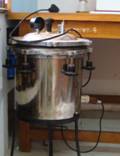
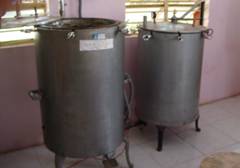
In biofertilizer production industry, equipments are the major infrastructure, which involves 70 percent of capital investment. Any compromise on the usage of the following mentioned equipments may finally decline in the quality of biofertilizer.After studying the principle behind the usage of all instruments, some of the instruments can be replaced with a culture room fitted with a U.V.Lamp. Autoclaves, Hot Air Oven, Incubators and sealing machines are indigenously made with proper technical specifications. The correct use of equipments will give uninterrupted introduction with quality inoculum.
Essential equipments
Autoclave


It is an apparatus in which materials are sterilized by air free saturated steam (under pressure) at a temperature above 100OC. If the steam pressure inside the autoclave is increased to 15 psi, the temperature will rise to 121°C. this is sufficient to destroy all vegetative cells. Normally all growth medium are sterilized in the autoclave.
Laminar air flow chamber
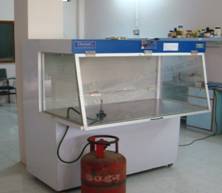
Laminar air flow chamber provides a uniform flow of filtered air. This continuous flow of air will prevent settling of particles in the work area.Air borne contamination is avoided in this chamber. Culture transfers and inoculation can be done here.
BOD incubators


Incubators providing controlled conditions (light, temperature, humidity, etc.) required for the growth and development of microorganisms. Multiplication of starter culture can be done in this instrument.
Rotary shaker
It is used for agitating culture flasks by circular motion under variable speed control. Shaking provides aeration for growth of cultures. Shakers holding upto 20-50 flasks are generally used. The capacity of the shaker may be increased if it is a double- decker type.
Hot air oven
Hot air oven is meant for sterilizing all glassware materials. Dry heat is used in this apparatus to sterilize the materials. Normally 180OC is used for two hours for sterilizing glasswares.
pH meter
An instrument for measuring pH of the solution using a 0-14 scale in which seven represents neutral points, less than seven is acidity (excess of H‘ over OH-) and more than seven is alkality (excess of OH- over H‘ ) useful in adjusting the pH of the growth medium.
Refrigerator
This equipment is used preserving all mother cultures used for biofertilizer production. The mother culture is periodically sub-cultured and stored in the refrigerator for long- term usage.
Fermentor
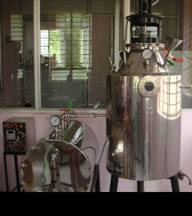
A fermentor is the equipment, which provides the proper environment for the growth of a desired organism. It is generally a large vessel in which, the organism may be kept at the required temperature, pH , dissolved oxygen concentration and substrate concentration. Different models of fermentors are available depending upon the necessity. A simple version model contains steam generator, sterilization process devices and agitator. A sophisticated fermentor contains pH regulator, oxygen level regulator, anti-foam device, temperature controller, etc.

Biofertilizers are carrier based preparations containing efficient strain of nitrogen fixing or phosphate solubilizing microorganisms. Biofertilizers are formulated usually as carrier based inoculants. The organic carrier materials are more effective for the preparation of bacterial inoculants. The solid inoculants carry more number of bacterial cells and support the survival of cells for longer periods of time.
- The mass production of carrier based bacterial biofertilizers involves three stages.
- Culturing of microorganisms
- Processing of carrier material
- Mixing the carrier and the broth culture and packing
Culturing of Microorganisms
Although many bacteria can be used beneficially as a biofertilizer the technique of mass production is standardizedfor Rhizobium, Azospirillum, Azotobacter and phosphobacteria.
The media used for mass culturing are as follows:
The media used for mass culturing are as follows:
Rhizobium : Yeast extract mannitol broth.
Growth on Congo red yeast extract mannitol agar medium
Mannitol | - | 10.0 g |
K2 HPO4 | - | 0.5 g |
Mg So4 7H2 O | - | 0.2 g |
NaCl | - | 0.1 g |
Yeast extract | - | 0.5 g |
Agar | 20.0 g | |
Distilled water | 1000.0 ml |
Add 10 ml of Congo red stock solution (dissolve 250 mg of Congo red in 100ml water) to 1 liter after adjusting the PH to 6.8 and before adding agar.
Rhizobium forms white, translucent, glistening, elevated and comparatively small colonies on this medium. Moreover, Rhizobium colonies do not take up the colour of congo red dye added in the medium. Those colonies which readily take up the congo red stain are not rhizobia but presumably Agrobacterium, a soil bacterium closely related to Rhizobium.
Azospirillum : Dobereiner's malic acid broth with NH4Cl (1g per liter)
Composition of the N-free semisolid malic acid medium
Malic acid | - | 5.0g |
Potassium hydroxide | - | 4.0g |
Dipotassium hydrogen orthophosphate | - | 0.5g |
Magnesium sulphate | - | 0.2g |
Sodium chloride | - | 0.1g |
Calcium chloride | - | 0.2g |
Fe-EDTA (1.64% w/v aqueous) | - | 4.0 ml |
Trace element solution | - | 2.0 ml |
BTB (0.5% alcoholic solution) | - | 2.0 ml |
Agar | - | 1.75 g |
Distilled water | - | 1000 ml |
pH | - | 6.8 |
Trace element solution | ||
Sodium molybdate | - | 200 mg |
Manganous sulphate | - | 235 mg |
Boric acid | - | 280 mg |
Copper sulphate | - | 8 mg |
Zinc sulphate | - | 24 mg |
Distilled water | - | 200 ml |
Waksman medium No.77 (N-free Mannitol Agar Medium for Azotobacter)
| Mannitol | : | 10.0 g |
| Ca CO3 | : | 5.0 g |
| K2HPO4 | : | 0.5 g |
| Mg SO4.7H2O | : | 0.2 g |
| NaCl | : | 0.2 g |
| Ferric chloride | : | Trace |
| MnSO4.4H2O | : | Trace |
| N-free washed Agar | : | 15.0 g |
| pH | : | 7.0 |
| Distilled Water | : | 1000 ml |
Phosphobacteria : Pikovskaya’s Broth
| Glucose | 10.0 g |
| Ca3(PO4)2 | 5.0 g |
| (NH4)2SO4 | 0.5 g |
| KCl | 0.2 g |
| MgSO4. 7H2O | 0.1 g |
| MnSO4 | Trace |
| FeSO4 | Trace |
| Yeast Extract | 0.5 g |
| Distilled Water | 1000 ml |
The broth is prepared in flasks and inoculum from mother culture is transferred to flasks. The culture is grown under shaking conditions at 30±2°C as submerged culture. The culture is incubated until maximum cell population of 1010 to 1011 cfu/ml is produced. Under optimum conditions this population level could be attained with in 4 to 5 days forRhizobium; 5 to 7 days for Azospirillum; 2 to 3 days for phosphobacteria and 6-7 days for Azotobacter. The culture obtained in the flask is called starter culture. For large scale production of inoculant, inoculum from starter culture is transferred to large flasks/seed tank fermentor and grown until required level of cell count is reached.
Inoculum preparation
- Prepare appropriate media for specific to the bacterial inoculant in 250 ml, 500 ml, 3 litre and 5 litre conical flasks and sterilize.
- The media in 250 ml flask is inoculated with efficient bacterial strain under aseptic condition
- Keep the flask under room temperature in rotary shaker (200 rpm) for 5- 7 days.
- Observe the flask for growth of the culture and estimate the population, which serves as the starter culture.
- Using the starter culture (at log phase) inoculate the larger flasks (500 ml, 3 litre and 5 litre) containing the media, after obtaining growth in each flask.
- The above media is prepared in large quantities in fermentor, sterilized well, cooled and kept it ready.
- The media in the fermentor is inoculated with the log phase culture grown in 5 litre flask. Usually 1 -2 % inoculum is sufficient, however inoculation is done up to 5% depending on the growth of the culture in the larger flasks.
- The cells are grown in fermentor by providing aeration (passing sterile air through compressor and sterilizing agents like glass wool, cotton wool, acid etc.) and given continuous stirring.
- The broth is checked for the population of inoculated organism and contamination if any at the growth period.
- The cells are harvested with the population load of 109 cells ml-1 after incubation period.
- There should not be any fungal or any other bacterial contamination at 10-6 dilution level
- It is not advisable to store the broth after fermentation for periods longer than 24 hours. Even at 4o C number of viable cells begins to decrease.
Processing of carrier material
The use of ideal carrier material is necessary in the production of good quality biofertilizer. Peat soil, lignite, vermiculite, charcoal, press mud, farmyard manure and soil mixture can be used as carrier materials. The neutralized peat soil/lignite are found to be better carrier materials for biofertilizer production The following points are to be considered in the selection of ideal carrier material.
- Cheaper in cost
- Should be locally available
- High organic matter content
- No toxic chemicals
- Water holding capacity of more than 50%
- Easy to process, friability and vulnerability.
Preparation of carrier material
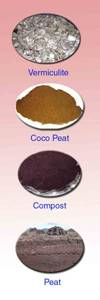
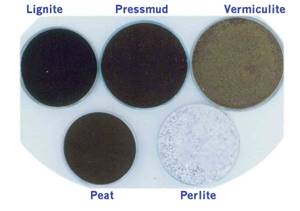
- The carrier material (peat or lignite) is powdered to a fine powder so as to pass through 212 micron IS sieve.
- The pH of the carrier material is neutralized with the help of calcium carbonate (1:10 ratio) , since the peat soil / lignite are acidic in nature ( pH of 4 - 5)
- The neutralized carrier material is sterilized in an autoclave to eliminate the contaminants.
Mixing the carrier and the broth culture and packing
Inoculant packets are prepared by mixing the broth culture obtained from fermentor with sterile carrier material as described below:
Preparation of Inoculants packet
- The neutralized, sterilized carrier material is spread in a clean, dry, sterile metallic or plastic tray.
- The bacterial culture drawn from the fermentor is added to the sterilized carrier and mixed well by manual (by wearing sterile gloves) or by mechanical mixer. The culture suspension is to be added to a level of 40 – 50% water holding capacity depending upon the population.
- The inoculant packet of 200 g quantities in polythene bags, sealed with electric sealer and allowed for curing for 2 -3 days at room temperature ( curing can be done by spreading the inoculant on a clean floor/polythene sheet/ by keeping in open shallow tubs/ trays with polythene covering for 2 -3 days at room temperature before packaging).

Schematic representation of mass production of bacterial biofertilizers
Specification of the polythene bags
- The polythene bags should be of low density grade.
- The thickness of the bag should be around 50 – 75 micron.
- Each packet should be marked with the name of the manufacturer, name of the product, strain number, the crop to which recommended, method of inoculation, date of manufacture, batch number, date of expiry, price, full address of the manufacturer and storage instructions etc.,
Storage of biofertilizerpacket
- The packet should be stored in a cool place away from the heat or direct sunlight.
- The packets may be stored at room temperature or in cold storage conditions in lots in plastic crates or polythene / gunny bags.
- The population of inoculant in the carrier inoculant packet may be determined at 15 days interval. There should be more than 109 cells / g of inoculant at the time of preparation and107 cells/ g on dry weight basis before expiry date.
Mass production of Mycorrhizal biofertilizer

The commercial utilization of mycorrhizal fungi has become difficult because of the obligate symbiotic nature and difficulty in culturing on laboratory media. Production of AM inoculum has evolved from the original use of infested field soils to the current practice of using pot culture inoculum derived from the surface disinfected spores of single AM fungus on a host plant grown in sterilized culture medium. Several researches in different parts of the world resulted in different methods of production of AM fungal inoculum as soil based culture as well as carrier based inoculum. Root organ culture and nutrient film technique provide scope for the production of soil less culture.
As a carrier based inoculum, pot culture is widely adopted method for production. The AM inoculum was prepared by using sterilized soil and wide array of host crops were used as host. The sterilization process is a cumbersome one and scientists started using inert materials for production of AM fungi. The researchers tried use of perlite, montmorillonite clay etc., In TNAU vermiculite was tried as substrate for the replacement of soil sterilization, which resulted in the best method of inoculum production.
Method of production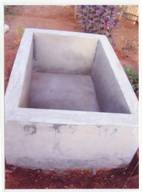

Tank for mass multiplication of AM
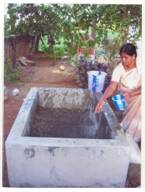

Sprinkling of water in tank with vermiculite
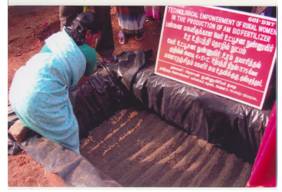
Making of furrows to sow maize seeds
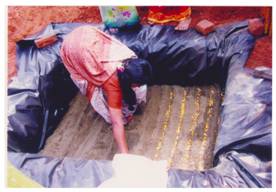
Sowing the seeds in furrows
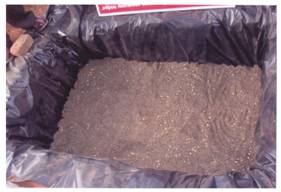
View of the maize sown AM pit
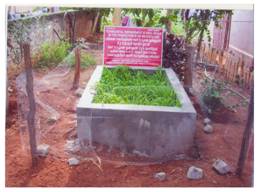
Vermiculite contained raised AM infected maize plants
- A trench (1m x 1m x 0.3m) is formed and lined with black polythene sheet to be used as a plant growth tub.
- Mixed 50 kg of vermiculite and 5 kg of sterilized soil and packed in the trench up to a height of 20 cm
- Spread 1 kg of AM inoculum (mother culture) 2-5 cm below the surface of vermiculite
- Maize seeds surface sterilized with 5% sodium hypochlorite for 2 minutes are sown
- Applied 2 g urea, 2 g super phosphate and 1 g muriate of potash for each trench at the time of sowing seeds. Further 10 g of urea is applied twice on 30 and 45 days after sowing for each trench
- Quality test on AM colonization in root samples is carried out on 30th and 45th day
- Stock plants are grown for 60 days (8 weeks). The inoculum is obtained by cutting all the roots of stock plants. The inoculum produced consists of a mixture of vermiculite, spores, pieces of hyphae and infected root pieces.
- Thus within 60 days 55 kg of AM inoculum could be produced from 1 sq meter area. This inoculum will be sufficient to treat 550 m2 nursery area having 11,000 seedlings.
AM fungi
Nursery application: 100 g bulk inoculum is sufficient for one metre square. The inoculum should be applied at 2-3 cm below the soil at the time of sowing. The seeds/cutting should be sown/planted above the VAM inoculum to cause infection.
For polythene bag raised crops: 5 to 10 g bulk inoculum is sufficient for each packet. Mix 10 kg of inoculum with 1000 kg of sand potting mixture and pack the potting mixture in polythene bag before sowing.
For out –planting: Twenty grams of VAM inoculum is required per seedling. Apply inoculum at the time of planting.
For existing trees: Two hundred gram of VAM inoculum is required for inoculating one tree. Apply inoculum near the root surface at the time of fertilizer application.
For existing trees: Two hundred gram of VAM inoculum is required for inoculating one tree. Apply inoculum near the root surface at the time of fertilizer application.
Mass production and field application of cyanobacteria

Blue green algal inoculation with composite cultures was found to be more effective than single culture inoculation. A technology for mass scale production of composite culture of blue green algae under rice field condition was developed at TNAU and the soil based BGA inoculum could survive for more than 2 years. At many sites where algal inoculation was used for three to four consecutive cropping seasons, the inoculated algae establish well and the effect persisted over subsequent rice crop. Technologies for utilizing nitrogen fixing organisms in low land rice were the beneficial role of blue green algal inoculation in rice soils of Tamil Nadu.
The blue green algal inoculum may be produced by several methods viz., in tubs, galvanized trays, small pits and also in field conditions. However the large-scale production is advisable under field condition which is easily adopted by farmers.
I. Multiplication in trays
- Big metallic trays (6’x 3’x 6”lbh) can be used for small scale production
- Take 10 kg of paddy field soil, dry powder well and spread
- Fill water to a height of 3”
- Add 250 g of dried algal flakes (soil based) as inoculum
- Add 150 g of super phosphate and 30 g of lime and mix well with the soil
- Sprinkle 25 g carbofuran to control the insects
- Maintain water level in trays
- After 10 to 15 days, the blooms of BGA will start floating on the water sources
- At this stage stop watering and drain. Let the soil to dry completely
- Collect the dry soil based inoculum as flakes
- Store in a dry place. By this method 5 to 7 kg of soil based inoculum can be obtained.
II. Multiplication under field condition
Materials
- Rice field
- Super phosphate
- Carbofuran
- Composite BGA starter culture
Select an area of 40 m2 (20m x 2m) near a water source which is directly exposed to sunlight.
Make a bund all around the plot to a height of 15 cm and give it a coating with mud to prevent loss of water due to percolation.
- Plot is well prepared and levelled uniformly and water is allowed to a depth of 5-7.5 cm and left to settle for 12 hrs.
- Apply 2 kg of super phosphate and 200 g lime to each plot uniformly over the area.
- The soil based composite starter culture of BGA containing 8-10 species @ 5 kg / plot is powdered well and broadcasted.
- Carbofuran @ 200 g is also applied to control soil insects occurring in BGA.
- Water is let in at periodic intervals so that the height of water level is always maintained at 5 cm.
- After 15 days of inoculation, the plots are allowed to dry up in the sun and the algal flakes are collected and stored.
The floating algal flasks are green or blue green in colour. From each harvest, 30 to 40 kg of dry algal flakes are obtained from the plot.
Method of inoculation of BGA in rice field
Blue green algae may be applied as soil based inoculum to the rice field following the method described below.
- Powder the soil based algal flakes very well.
- Mix it with 10 kg soil or sand (10kg powdered algal flakes with 10 kg soil / sand).
- BGA is to be inoculated on 7-10 days after rice transplanting.
- Water level at 3-4” is to be maintained at the time of BGA inoculation and then for a month so as to have maximum BGA development.
A week after BGA inoculation, algal growth can be seen and algal mat will float on the water after 2-3 weeks. The algal mat colour will be green or brown or yellowish green.
Mass production and field application of Azolla
Azolla is a free-floating water fern that floats in water and fixes atmospheric nitrogen in association with nitrogen fixing blue green alga Anabaena azollae. Azolla fronds consist of sporophyte with a floating rhizome and small overlapping bi-lobed leaves and roots. Rice growing areas in South East Asia and other third World countries have recently been evincing increased interest in the use of the symbiotic N2 fixing water fern Azolla either as an alternate nitrogen sources or as a supplement to commercial nitrogen fertilizers. Azolla is used as biofertilizer for wetland rice and it is known to contribute 40-60 kg N ha-1 per rice crop. The agronomic potential of Azolla is quite significant particularly for rice crop and it is widely used as biofertilizer for increasing rice yields. Rice crop response studies with Azolla biofertilizer in the People’s Republic in China and in Vietnam have provided good evidence that Azollaincorporation into the soil as a green manure crop is one of the most effective ways of providing nitrogen source for rice.
The utilization of Azolla as dual crop with wetland rice is gaining importance in Philippines, Thailand, Srilanka and India. The important factor in using Azolla as a biofertilizer for rice crop is its quick decomposition in soil and efficient availability of its nitrogen to rice. In tropical rice soils the applied Azolla mineralizes rapidly and its nitrogen is available to the rice crop in very short period. The common species of Azolla are A. microphylla, A. filiculoides, A. pinnata, A. caroliniana, A. nilotica, A. rubra and A. mexicana.
I. Mass multiplication of Azolla under field conditions
A simple Azolla nursery method for large scale multiplication of Azolla in the field has been evolved for easy adoption by the farmers.
Materials
- One cent (40 sq.m) area plot
- Cattle dung
- Super phosphate
- Furadan
- Fresh Azolla inoculum
Procedure
- Select a wetland field and prepare thoroughly and level uniformly.
- Mark the field into one cent plots (20 x 2m) by providing suitable bunds and irrigation channels.
- Maintain water level to a height of 10 cm.
- Mix 10 kg of cattle dung in 20 litres of water and sprinkle in the field.
- Apply 100 g super phosphate as basal dose.
- Inoculate fresh Azolla biomass @ 8 kg to each pot.
- Apply super phosphate @ 100 g as top dressing fertilizer on 4th and 8th day after Azolla inoculation.
- Apply carbofuran (furadan) granules @ 100 g/plot on 7th day after Azolla inoculation.
- Maintain the water level at 10 cm height throughout the growth period of two or three weeks.
- Observations
- Note the Azolla mat floating on the plot. Harvest the Azolla, drain the water and record the biomass.
II. Method of inoculation of Azolla to rice crop
The Azolla biofertilizer may be applied in two ways for the wetland paddy. In the first method, fresh Azolla biomass is inoculated in the paddy field before transplanting and incorporated as green manure. This method requires huge quantity of fresh Azolla. In the other method, Azolla may be inoculated after transplanting rice and grown as dual culture with rice and incorporated subsequently.
A. Azolla biomass incorporation as green manure for rice crop
- Collect the fresh Azolla biomass from the Azolla nursery plot.
- Prepare the wetland well and maintain water just enough for easy incorporation.
- Apply fresh Azolla biomass (15 t ha-1) to the main field and incorporate the Azolla by using implements or tractor.
- Select a transplanted rice field.
- Collect fresh Azolla inoculum from Azolla nursery.
- Broadcast the fresh Azolla in the transplanted rice field on 7th day after planting (500 kg / ha).
- Maintain water level at 5-7.5cm.
- Note the growth of Azolla mat four weeks after transplanting and incorporate the Azolla biomass by using implements or tranctor or during inter-cultivation practices.
- A second bloom of Azolla will develop 8 weeks after transplanting which may be incorporated again.
- By the two incorporations, 20-25 tonnes of Azolla can be incorporated in one hectare rice field.
1. Seed treatment or seed inoculation
2. Seedling root dip
3. Main field application
2. Seedling root dip
3. Main field application
Seed treatment
One packet of the inoculant is mixed with 200 ml of rice kanji to make a slurry. The seeds required for an acre are mixed in the slurry so as to have a uniform coating of the inoculant over the seeds and then shade dried for 30 minutes. The shade dried seeds should be sown within 24 hours. One packet of the inoculant (200 g) is sufficient to treat 10 kg of seeds.
Seedling root dip
This method is used for transplanted crops. Two packets of the inoculant is mixed in 40 litres of water. The root portion of the seedlings required for an acre is dipped in the mixture for 5 to 10 minutes and then transplanted.
Main field application
Four packets of the inoculant is mixed with 20 kgs of dried and powdered farm yard manure and then broadcasted in one acre of main field just before transplanting.
Rhizobium
For all legumes Rhizobium is applied as seed inoculant.
Azospirillum/Azotobacter
In the transplanted crops, Azospirillum is inoculated through seed, seedling root dip and soil application methods. For direct sown crops, Azospirillum is applied through seed treatment and soil application.
Phosphobacteria
Inoculated through seed, seedling root dip and soil application methods as in the case of Azospirillum.
Combined application of bacterial biofertilizers.
Combined application of bacterial biofertilizers.
Phosphobacteria can be mixed with Azospirillum and Rhizobium. The inoculants should be mixed in equal quantities and applied as mentioned above.
Points to remember
- Bacterial inoculants should not be mixed with insecticide, fungicide, herbicide and fertilizers.
- Seed treatment with bacterial inoculant is to be done at last when seeds are treated with fungicides.
Biofertilizers recommendation (one packet - 200 g)
| S. No. | Crop | Seed | Nursery | Seedling dip | Main field | Total requirement of packets per ha |
1. | Rice | 5 | 10 | 5 | 10 | 30 |
2. | Sorghum | 3 | - | - | 10 | 13 |
3. | Pearl millet | 3 | - | - | 10 | 13 |
4. | Ragi | 3 | - | 5 | 10 | 18 |
5. | Maize | 3 | - | - | 10 | 13 |
6. | Cotton | 3 | - | - | 10 | 13 |
7. | Sunflower | 3 | - | - | 10 | 13 |
8. | Castor | 3 | - | - | 10 | 13 |
9. | Sugarcane | 10 | - | - | 36 (3 split) | 46 |
10. | Turmeric | - | - | - | 24 (2 split) | 24 |
11. | Tobacco | 1 | 3 | - | 10 g/pit | 14 |
12. | Papaya | 2 | - | - | 10 | - |
13. | Mandarin Orange | 2 | - | - | 10 g/pit | - |
14. | Tomato | 1 | - | - | 10 | 14 |
15. | Banana | - | - | 5 | 10 g/pit | - |
Rhizobium (only seed application is recommended)
| S. No. | Crop | Total requirement of packets per ha |
| 1. | Soybean | 5 |
2. | Groundnut | 5 |
3. | Bengalgram | 5 |
4. | Blackgram | 3 |
5. | Greengram | 3 |
6. | Redgram | 3 |
7. | Cowpea | 3 |
Phosphobacteria
The recommended dosage of Azospirillum is adopted for phosphobacteria inoculation; for combined inoculation, both biofertilizers as per recommendations are to be mixed uniformly before using.
The recommended dosage of Azospirillum is adopted for phosphobacteria inoculation; for combined inoculation, both biofertilizers as per recommendations are to be mixed uniformly before using.

Azolla is a free floating water fern that floats in water and fixes nitrogen in association with the nitrogen fixing blue green algae, Anabaena azollae. Azolla is considered to be a potential biofertilizer in terms of nitrogen contribution to rice. Long before its cultivation as a green manure, Azolla has been used as a fodder for domesticated animals such as pigs and ducks. In recent days, Azolla is very much used as a sustainable feed substitute for livestock especially dairy cattle, poultry, piggery and fish.
Azolla contains 25 – 35 per cent protein on dry weight basis and rich in essential amino acids, minerals, vitamins and carotenoids including the antioxidant b carotene. Cholorophyll a, chlorophyll b and carotenoids are also present in Azolla, while the cyanobiont Anabaena azollae contains cholorophyll a, phycobiliproteins and carotenoids. The rare combination of high nutritive value and rapid biomass production make Azolla a potential and effective feed substitute for live stocks.
Inputs required
Azolla fronds, Polythene sheet, Super phosphate and Cow dung.
Methodology
The area selected for Azolla nursery should be partially shaded. The convenient size for Azolla is 10 feet length, 2 feet breadth and 1 feet depth. The nursery plot is spread with a polythene sheet at the bottom to prevent water loss. Soil is applied to a depth of 2 cm and a gram of super phosphate is applied along with 2 kg of vermicompost or cow dung in the nursery for quick growth. Azolla mother inoculum is introduced @ 5 kg/plot.
The contents in the plot are stirred daily so that the nutrients in the soil dissolve in water for easy uptake by Azolla. Azolla is harvested fifteen days after inoculation at the rate of 50-80 kg / plot. One third of Azolla should be left in the plot for further multiplication. Five kg cow dung slurry should be sprinkled in the Azolla nursery at ten days intervals. Neem oil can be sprayed over the Azolla at 0.5 5 level to avoid pest incidence.
| Animal | Dosage / day |
| Adult cow , Buffalo, Bullock | 1.5-2 kg |
| Layer, Broiler birds | 20 – 30 grams |
| Goat | 300 – 500 grams |
| Pig | 1.5 – 2.0 kg |
| Rabbit | 100 gram |
Value of the technology
The egg yield is increased in layer birds due to Azolla feeding. The Azolla fed birds register an overall egg productivity of 89.0 per cent as against 83.7 per cent recorded by the birds fed with only concentrated feed. The average daily intake of concentrated feed is considerably low (106.0 g) for birds due to Azolla substitution as against 122.0 g in the control birds. More impotantly Azolla feeding shows considerable amount of savings in the consumption of concentrated feed (13.0 %) leading to reduced operational cost. By considering the average cost of the concentrated feed as Rs. 17/ Kg, a 13.0 % saving in the consumption ultimately leads to a feed cost savings of 10.0 paise /day/ bird and hence a layer unit maintaining 10,000 birds could cut down its expense towards feed to a tune of rs.1000/day.
Benefits
The Azolla feeding to layer birds increase egg weight, albumin, globulin and carotene contents. The total protein content of the eggs laid by the Azolla fed birds is high and the total carotene content of Azolla eggs(440 g 100 g-1 of edible portion)is also higher than the control. The rapid biomass production due to the high relative growth rate, increased protein and carotene contents and good digestability of the Azolla hybrid Rong ping favour its use as an effective feed supplement to poultry birds.
The Azolla feeding to layer birds increase egg weight, albumin, globulin and carotene contents. The total protein content of the eggs laid by the Azolla fed birds is high and the total carotene content of Azolla eggs(440 g 100 g-1 of edible portion)is also higher than the control. The rapid biomass production due to the high relative growth rate, increased protein and carotene contents and good digestability of the Azolla hybrid Rong ping favour its use as an effective feed supplement to poultry birds.
Effect of Azolla hybrid Rong Ping on the nutritional value of egg
| Parameters | Azolla egg | Control | percentage increase over control |
| Egg weight (g) | 61.20 | 57.40 | 6.62 |
| Albumin (g /100 g of edible portion) | 3.9 | 3.4 | 14.70 |
| Globulin (g /100 g of edible portion) | 10.1 | 9.5 | 6.31 |
| Total protein (g/ 100 g of edible portion) | 14.0 | 12.9 | 8.52 |
| Carotenes (µg / 100 g of edible portion) | 440 | 405 | 8.64 |
Application
In Indian conditions, agriculture is very much coupled with poultry farming. Azolla is an important low cost input, which plays a vital role in improving soil quantity in sustainable rice farming. The twin potentials as biofertilizer and animal feed make the water fern Azolla as an effective input to both the vital components of integrated farming, agricultural and animalo husbandry.
Limitation
Azolla is a water fern and requires a growth temperature of 35-38º C. The multiplication of Azolla is affected under elevated temperature. Hence adopting this technology in dry zones where the temperature exceeds 40ºc is difficult.
Achievements
Azolla hybrid Rong ping had been selected to supply to the tribal population. Azolla mother inoculum nursery was laid out in villages with the help of Krishi Vigyan Kendra, TNAU, Coimbatore and Krishi Vigyan Kendra, Karamadai, women entrepreneurs were selected and one day training was imparted to them on the cultivation of Azolla. Wet biomass (Starter inoculm) were supplied at free of cost @ 10 kg/women entrepreneur during the training so as to enable them to initiate commercial Azolla cultivation in their backyards.
Azolla multiplication plots had been laid out in Narasipuram. Azolla mass production training was conducted to the SHG in Narasipuram village with the help of Kalaimagal Arts and Science College, Narasipuram, Sappanimadai (tribal village) and Avinashilingam KVK, Karamadai. With the help of Avinashilingam KVK, Karamadai Azolla trainings were conducted to women volunteers and we have established Azolla village in Karamadai. The Avin milk producers union Coimbatore and the poultry owners association, Namakkal have been contacted and explained the importance of Azolla as feed supplement.
The Milk Producers Union also involved in the training and marketing of Azolla. They are purchasing Azolla fronds from the village level Azolla growers both under wet and dry conditions. Around 400 rural women and 370 tribal people have been trained on the cultivation of Azolla through this project. The Azolla laboratory and the Azolla germplasm center at AC& RI, TNAU, Coimbatore helped us in the maintenance of germplasm by providing the mother inoculum. The Animal Husbandry Unit at AC&RI, TNAU, Coimbatore helped us in standardizing the Azolla and concentrated feed mixing ratio.

Azolla mass multiplication in pits
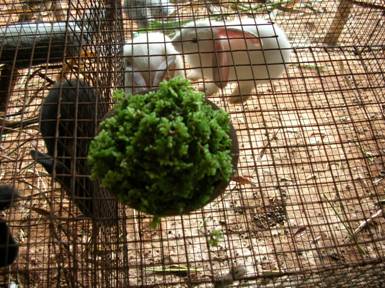
Feeding Azolla to Rabbit
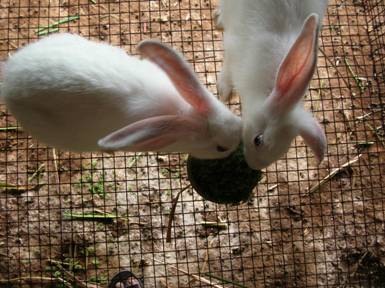
Feeding Azolla to Rabbit
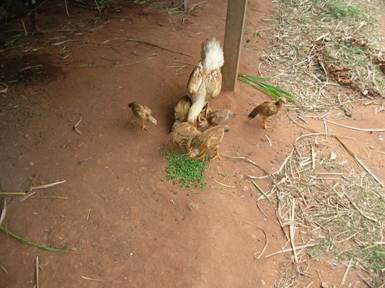
Feeding Azolla to Poultry
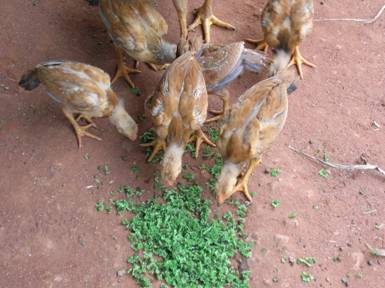
Feeding Azolla to Poultry
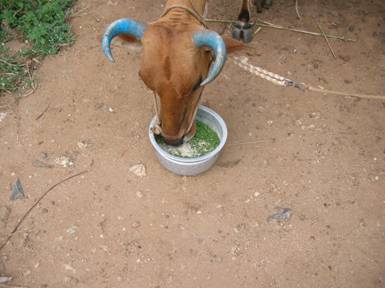
Feeding Azolla to Livestock
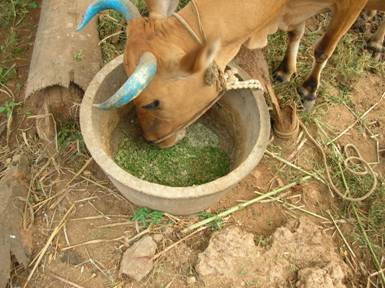
Feeding Azolla to Livestock

Inoculating Super phosphate and Cow dung in Azolla pit
Department of Agricultural Microbiology, Agriculture College and Research Institute,
Tamil Nadu Agricultural University
Dr. S. Anthoniraj
MADURAI-625 104
( 0452-422956 fax: 422785
e-mail: s_anthoniraj@yahoo.com
Biofertilizer Production Unit, Department of Agriculture, Govt. of Tamil Nadu
Gundusalai Road, Sommandalam,
CUDDALORE-607 001 (TN)
Tamil Nadu Agricultural University
Dr. S. Anthoniraj
MADURAI-625 104
( 0452-422956 fax: 422785
e-mail: s_anthoniraj@yahoo.com
Biofertilizer Production Unit, Department of Agriculture, Govt. of Tamil Nadu
Gundusalai Road, Sommandalam,
CUDDALORE-607 001 (TN)
Biofertilizer Production Unit, Department of Agriculture, Govt. of Tamil Nadu
Agricultural Chemist
Sakkottai,
THANTAVUR-612 401 (TN)
Agricultural Chemist
Sakkottai,
THANTAVUR-612 401 (TN)
Biofertilizer Production Unit, Department of Agriculture, Govt. of Tamil Nadu
Jamal Mohd. College Post, Khajamalai,
TRICHY-620 020 (TN)
Jamal Mohd. College Post, Khajamalai,
TRICHY-620 020 (TN)
KRIBHCO
Sidco Garment Complex, Thiruvika Industrial Estate, Guidy,
CHENNAI-32
Sidco Garment Complex, Thiruvika Industrial Estate, Guidy,
CHENNAI-32
Regional Research Station
Tamil Nadu Agricultural University,
PIYUR-635 112
Via-Kaveripattinam
Dharmapuri District
( 04343-50043
Tamil Nadu Agricultural University,
PIYUR-635 112
Via-Kaveripattinam
Dharmapuri District
( 04343-50043
Monarch Bio-Fertilisers and Research Centre
12, SIDCO Industrial Estate, Thirumazhisai,
CHENNAI-602 107 (TN)
( 6272780
12, SIDCO Industrial Estate, Thirumazhisai,
CHENNAI-602 107 (TN)
( 6272780
Lakshmi Bio-Tech
Mr. V. Sithanandham
Nellikuppam Road, Thottapattu,
CUDDALORE-607 109 (TN)
(
Mr. V. Sithanandham
Nellikuppam Road, Thottapattu,
CUDDALORE-607 109 (TN)
(
Marygreen Afrotech (P) Ltd.
Dr. Y. Joe
5/302, Srisaibaba St., Santosh Nagar, Kandanchavadi, Perungudi Post,
CHENNAI-600 096 (TN)
4964202, 4745957
e-mail: marygreen45@hotmail.com
Dr. Y. Joe
5/302, Srisaibaba St., Santosh Nagar, Kandanchavadi, Perungudi Post,
CHENNAI-600 096 (TN)
4964202, 4745957
e-mail: marygreen45@hotmail.com
Tamil Nadu Agricultural University
Prof. & Head
Deptt. of Agricultural Microbiology,
COIMBATORE-3 (TN)
( 431222 ext. 294 Fax: 0422-431672
e-mail: vctnau@vsnl.com
Prof. & Head
Deptt. of Agricultural Microbiology,
COIMBATORE-3 (TN)
( 431222 ext. 294 Fax: 0422-431672
e-mail: vctnau@vsnl.com
T Stanes & Company Limited
Dr. S. Ramarethinam
8/23-24, Race Course Road,
COIMBATORE-641 018 (TN)
( , 213515 Fax: 217432
e-mail: tstanes@vsnl.com
Dr. S. Ramarethinam
8/23-24, Race Course Road,
COIMBATORE-641 018 (TN)
( , 213515 Fax: 217432
e-mail: tstanes@vsnl.com
Esvin Advanced Technologies Limited
Mr. T. S. Venkataraman
“Esvin House” Perungudi,
CHENNAI-600 096 (TN)
( 4961056,4960690 Fax: 4961002
e-mail: tsv@vsnl.com
Mr. T. S. Venkataraman
“Esvin House” Perungudi,
CHENNAI-600 096 (TN)
( 4961056,4960690 Fax: 4961002
e-mail: tsv@vsnl.com
Southern Petrochemical Industries Corporation Limited,
Mr. K. Raju
SPIC Ltd. Biotechnology Division, Chettiar Agaram Road, Gandhi Nagar, Porur,
CHENNAI-600 116 (TN)
( 044-4768064 Tele-Fax: 044-4767347
e-mail: biotech.por@spic.co.in
Mr. K. Raju
SPIC Ltd. Biotechnology Division, Chettiar Agaram Road, Gandhi Nagar, Porur,
CHENNAI-600 116 (TN)
( 044-4768064 Tele-Fax: 044-4767347
e-mail: biotech.por@spic.co.in
Biofertiliser Unit-Manali, Madras Fertilizers Limited
Mr. P. Mallikarjuna Reddy
Chief Manager –Bioproducts
Commercial Group, Madras Fertilizers Ltd., Manali,
CHENNAI-600 068 (TN)
( 044-5941001 ext. 2750 Fax: 5941010
e-mail: edcomm@mfl.tn.nic.in
Mr. P. Mallikarjuna Reddy
Chief Manager –Bioproducts
Commercial Group, Madras Fertilizers Ltd., Manali,
CHENNAI-600 068 (TN)
( 044-5941001 ext. 2750 Fax: 5941010
e-mail: edcomm@mfl.tn.nic.in
Biofertilizer Production Unit
Mr. S. Murugan
Agricultural Chemist, Biofertilizer Production Unit, Seelanaickenpatty,
SALEM-636 201 (TN)
Mr. S. Murugan
Agricultural Chemist, Biofertilizer Production Unit, Seelanaickenpatty,
SALEM-636 201 (TN)
Biofertilizer Production Unit,
Mr.Thiru P. Raman
Agricultural Chemist, Biofertilizer Production Unit,
KUDUMIAMALAI-622 104
Distt. Pudukkottai
Mr.Thiru P. Raman
Agricultural Chemist, Biofertilizer Production Unit,
KUDUMIAMALAI-622 104
Distt. Pudukkottai
Main Biocontrol Research Laboratory
(Unit of Tamilnadu Cooperative Sugar Federation)
2E/1, Rajeshwari Vedhachalam Street,
CHENGALPATTU-603 001 (TN)
( 04114-431393
(Unit of Tamilnadu Cooperative Sugar Federation)
2E/1, Rajeshwari Vedhachalam Street,
CHENGALPATTU-603 001 (TN)
( 04114-431393
The SIMA Cotton Development and Research Association
Dr. M.A. Shanmugham
“Shanmukha Manram”, Post Box No. 3871, Race Course,
COIMBATORE-641 018 (TN)
( 0422-211391 Tele-Fax: 0422-216798
Dr. M.A. Shanmugham
“Shanmukha Manram”, Post Box No. 3871, Race Course,
COIMBATORE-641 018 (TN)
( 0422-211391 Tele-Fax: 0422-216798
Though the biofertilizer technology is a low cost, ecofriendly technology, several constraints limit the application or implementation of the technology the constraints may be environmental, technological, infrastructural, financial, human resources, unawareness, quality, marketing, etc. The different constraints in one way or other affecting the technique at production, or marketing or usage.
Technological constraints
- Use of improper, less efficient strains for production.
- Lack of qualified technical personnel in production units.
- Unavailability of good quality carrier material or use of different carrier materials by different producers without knowing the quality of the materials.
- Production of poor quality inoculants without understanding the basic microbiological techniques
- Short shelf life of inoculants.
- Non-availability of suitable facilities for production
- Lack of essential equipments, power supply, etc.
- Space availability for laboratory, production, storage, etc.
- Lack of facility for cold storage of inoculant packets
- Non-availability of sufficient funds and problems in getting bank loans
- Less return by sale of products in smaller production units.
- Seasonal demand for biofertilizers
- Simultaneous cropping operations and short span of sowing/planting in a particular locality
- Soil characteristics like salinity, acidity, drought, water logging, etc.
- Lack of technically qualified staff in the production units.
- Lack of suitable training on the production techniques.
- Ignorance on the quality of the product by the manufacturer
- Non-availability of quality specifications and quick quality control methods
- No regulation or act on the quality of the products
- Awareness on the technology
- Unawareness on the benefits of the technology
- Problem in the adoption of the technology by the farmers due to different methods of inoculation.
- No visual difference in the crop growth immediately as that of inorganic fertilizers.
- Unawareness on the benefits of the technology.
- Problem in the adoption of the technology by the farmers due to different methods of inoculation.
- No visual difference in the crop growth immediately as that of inorganic fertilizers.
- Unawareness on the damages caused on the ecosystem by continuous application of inorganic fertilizer.
- Non availability of right inoculant at the right place in right time.
- Lack of retain outlets or the market network for the producers.
| Azospirillum | Strains |
| Normal soils | Az. 204 |
| Acid soils | Az Y2 |
| Dry lands | Azt. 11 |
| Rhizobium | |
| Groundnut | TNAU 14 |
| Soybean | Cos 1 |
| Cowpea | Coc 10 |
| Redgram | Cc 1 |
| Greengram & Blackgram | COG 15 |
| GMBS 1 | |
| Bengalgram | CoBe 13 |
| Phosphobacteria | |
| All crops | PB 1 |
The increasing demand for the biofertilizers and the awareness among farmers and planters in the use of biofertilizers have paved way for the fertilizer manufactures and new entrepreneurs to get into biofertilizer production. A number of biofertilizer production units have been started recently particularly in the southern states of our country.
Nationalized banks have started their Hi-Tech agricultural programme providing loan and motivated the entrepreneurs to start their own production units. The Government of India is also encouraging this low cost technology by providing a subsidy upto Rs.20 lakhs to start a production unit with the capacity of 150 metric tonnes per annum. However, we are all aware that the success of the project entirely depends on the economic viability. With the objective of giving an overall economics of the biofertilizer production and sales, an approximate estimate is prepared.
Total estimate for starting a biofertilizer production unit with the capacity of 150 metric tonnes/annum.
S. No. | Particulars | Amount (Rs.in lakhs) | |
I. | Expenditure* | ||
A. | Capital Investment (Fixed cost) | ||
i. | Building including cost of site (App. 1200 sq. ft.) | : | 12.00 |
ii. | Equipment and apparatus | : | 41.00 |
B. | Operational cost (variable cost) | ||
i. | Working capital (Raw materials) | : | 10.00 |
ii. | Staff salary | : | 2.04 |
iii. | Labour | : | 2.50 |
iv. | Electricity | : | 0.50 |
v. | Travelling expenses | : | 0.50 |
vi. | Administrative expenses | : | 0.50 |
vii. | Interest on loan and depreciation | : | 0.70 |
viii. | Miscellaneous expenses | : | 0.26 |
| Total (variable cost) | : | 17.00 | |
| Total investment | : | 70.00 | |
| Actual initial investment | : | 50.00 |
* The expenditures does not include the marketing expenses
Expenditure details (Rupees in lakhs)
S.No. | Equipment and apparatus | Qty (Nos.) | Amount (Rs.in lakhs) |
1. | Fermentor (200 lit. capacity) | 4 | 26.00 |
2. | Shaker | 2 | 1.50 |
3. | Laminar air flow chamber | 1 | 0.60 |
4. | Autoclave | 2 | 0.30 |
5. | Hot air oven | 1 | 0.10 |
6. | Incubator | 1 | 0.10 |
7. | Refrigerator | 1 | 0.30 |
8. | Microscope | 1 | 0.75 |
9. | pH meter | 1 | 0.15 |
10. | Physical balance | 1 | 0.10 |
11. | Electronic balance | 1 | 0.75 |
12. | Counter-poise balance | 5 | 0.25 |
13. | Sealing machine | 5 | 0.25 |
14. | Work benches | 4 | 0.30 |
15. | Plastic trays | 50 | 0.25 |
16. | Trays (Zinc/Aluminium) | 10 | 0.20 |
17. | Trolley | 1 | 0.10 |
18. | Automatic packing machine (optional) | 1 | 9.00 |
| Total | 41.00 |
Working capital
1. | cost of mother culture | : | 0.05 |
2. | Glasswares | : | 0.70 |
3. | Chemicals | : | 2.50 |
4. | Polythene bags | : | 3.50 |
5. | Carrier materials | : | 3.00 |
6. | Miscellaneous items | : | 0.25 |
| Total | : | 10.00 |
Staff salary
| Technical staff (1 No.) | : | 9000 x 12 | 1,08,000 |
| Laboratory staff (2 Nos.) | : | 4000 x 2 x 12 | 96,000 |
Total | 2,04,000 |
II. Production
| 60% capacity | : | 90 MT per year |
| 75% capacity | : | 112.5 MT per year |
100% capacity | : | 150 MT per year |
III. Receipts
| Cost of 1 kg of biofertilizer (present Govt./University rate) | : | Rs.25/- |
| Cost of 90 MT (60% capacity) | : | 22.500 lakh rupees |
| 112.5 MT (75% capacity) | : | 28.125 lakh rupees |
| 135 MT (90% capacity) | : | 33.750 lakh rupees |
| 150 MT (100% capacity) | 37.500 lakh rupees |
IV. Profitability
Year | Production | Receipt (Lakh Rs.) | Expenditure (Lakh Rs.) | Gain (Lakh Rs.) |
I | 60% | 22.500 | 50.000 | -27.500 |
II | 75% | 28.125 | 18.700* | 9.425 |
III | 90% | 33.750 | 20.570* | 13.180 |
IV | 100% | 37.500 | 22.630* | 14.870 |
Profit anticipated after 4 years | 9.975 | |||
*Every year 10% increase in the expenditure is calculated to balance the price escalation
Economics of AM biofertilizer – Mass production
I | Capital cost ( for construction of pits size of 4x 3x1.5 ft including construction material sand labour cost) | Rs.3,000/- |
2 | Inoculum cost ( from TNAU) 20 KG @ Rs.20/- per kg | Rs.400/- |
3 | Vermiculite cost (including transport charges) 500kg@ Rs.6.50 | Rs.3,250/- |
4 | Labour cost-Since it is a single pit, family members can look after | NA |
5 | Seed materials and mesh for covering for pits | Rs.100+100 |
6 | Quality control charges at TNAU (This will be done after 1 year and before selling the product & need not be carried out after each harvest) | Rs.1,000/- |
7 | Bag- cost of packing the materials-30 @ Rs.10 each Labour cost of harvesting and packing | Rs.300/- Rs.200/- |
Total | Rs.8,350/- | |
8 | Benefit expected by the sale of produced inoculum 500kg @ Rs.20/- per kg (In TNAU) Rs.35/- per kg ( In Private) | Rs.10,000/- Rs.17,500/- |
9 | Net Income ( First harvest) Rs.10,000-8,350( Sl.No.8 – Sl.No 1 to 7) Rs.17,500-8,350 | Rs.1,197/- Rs.9,150/- |
10 | For the II harvest the cost will be | Rs.4,950/- |
11 | From the second harvest benefit will be of Rs.10,000/ - Rs.4,950/ Rs.17,500/ - Rs.4,950/ | Rs. 5,050/- Rs.12,550/- |
12 | The Net Income for one year will be Rs.50,000/ -Rs.24,750/ Rs.87,500/ -Rs.24,750/ | Rs.25,250/- Rs.62,750/- |
Name of Biofertilizers | Cost of Biofertilizers | Availabilty |
Azospirillum | Rs.40/Kg | Professor and Head Department of Agricultural Microbiology Tamil Nadu Agricultural University Coimbatore - 641 003 Phone: Fax: 91-422-2431672 Email: microbiology@tnau.ac.in |
Phosphobacteria | Rs.40/Kg | |
Rhizobium | Rs.40/Kg | |
Azotobacter | Rs.40/Kg | |
VAM | Rs.30/Kg |
Source
Entrepreurial Training Manual
The Professor and Head
Department of Microbiology
Tamil Nadu Agricultural University,
Coimbatore-3
The Professor and Head
Department of Microbiology
Tamil Nadu Agricultural University,
Coimbatore-3
KBCagri provided Liquid biofertilizers suppliers in india and liquid biofertilizer wholesalers in india. liquid biofertilizers suppliers in tamilnadu, india. VIEW MORE :- Liquid biofertilizers manufacturers in india
ReplyDeleteA Bio Fertilizer Manufacturer in India is manufacture best fertilizer and former to Extend more the production of crops .The leuid fertilizer used to soil and improve the quality of soil.
ReplyDeleteI am interested in bringing this technology to Nigeria. How does this work?
ReplyDeleteThank you for share with us. Keep Posting About Fermentation and Please Share Knowledge so We Can Aware About Fermentation and rotary shaker Manufacturer in India
ReplyDeleteGreat Opportunity for my business Rotary Shaker Manufacturer in india & orbital shaker manufacturer in ahmedabad & incubator shaker manufacturer in ahmedabad & Laboratory fermenter manufacturer in ahmedabad & industrial fermenter manufacturer in ahmedabad & uma pharmatech machinery. I need support to approval the comment some people view our business.
ReplyDeleteWe would like to introduce our-self as a leading Manufacturers and Exporters of Biopharma Machinerys Like( Fermenter, Bioreactor, Autoclave, Rotary Flask Shaker, Incubator Shaker, Biofertilizer Plant, Turn Key Based Projects, SS Vessels and Tanks, Electric Steam Boiler Etc..........)
We are a well-known brand in India and International for manufacturing Processing Equipment and Machinery with number of reputed clients around the globe. Our Company has a distinguished record of success for providing leading technology and cost effective solutions to their clients.
We have an established quality system for manufacturing various equipment likewise:
• Fermenter
• Bioreactor
• Autoclave
• Rotary Flask Shaker
• Incubator Shaker
• Biofertilizer Plant
• SS Vessels and Tanks
• Electric Steam Boiler
• Fermenter Accessory
• Tc Fittings and Pipe Fittings For Pharmaceutical Machinerys
• Electric Steam Boiler
Regards
UMA PHARMATECH MACHINERY(CEO)
Mr. Ankur Patel
(+91-9726923885)
umapharmatechmachinerys@gmail.com
Ankur patel | Managing Director | Uma Pharmatech Machinery |
Address: 14, Narayan Chamber, Jogeshwari Estate, Sureliya Road, Pin-380026 , ahmedabad | Gujarat | India |
Thanks for sharing the very important information about the Bio fertilizers in deep details, keep posting more about like this. Also tell me more about farming equipment's.
ReplyDeletehttp://www.skrgroup.co.in/our-products/
I am glad to find amazing information from the blog. Thanks for sharing the information.
ReplyDeleteOrganic Fertilizer in Bangalore | Garden Pots in Bangalore
UMA PHARMATECH MACHINERY(CEO)
DeleteMr. Ankur Patel
(+91-9726923885)
umapharmatechmachinerys@gmail.com
Ankur patel | Managing Director | Uma Pharmatech Machinery |
Address: 14, Narayan Chamber, Jogeshwari Estate, Sureliya Road, Pin-380026 , ahmedabad | Gujarat | India |"
I want to start biofertilizer plant....anyone can guidance me here...
ReplyDeleteI am from maharashtra.....where can we start.....which place,which area...industrial or local people place.....plz give me every essential basic to advance level of plant....plz msg me for guidance....you can dm me at email and i give here my whatsapp number....7420095959....plz contact with me....
"Great Opportunity for my business fermenter manufacturing companies & bioreactor manufacturers india & fermenter price list india &
Deletefermenter price in india & industrial fermenter cost & laboratory fermenter price & lab scale fermenter pdf & lab scale fermentor system & laboratory fermenter wikipedia &
bio fertilizer plant cost in india & uma pharmatech machinery.Thanks For Your Support
Regards
UMA PHARMATECH MACHINERY(CEO)
Mr. Ankur Patel
(+91-9726923885)
umapharmatechmachinerys@gmail.com
Ankur patel | Managing Director | Uma Pharmatech Machinery |
Address: 14, Narayan Chamber, Jogeshwari Estate, Sureliya Road, Pin-380026 , ahmedabad | Gujarat | India |"
"Great Opportunity for my business fermenter manufacturing companies & bioreactor manufacturers india & fermenter price list india &
Deletefermenter price in india & industrial fermenter cost & laboratory fermenter price & lab scale fermenter pdf & lab scale fermentor system & laboratory fermenter wikipedia &
bio fertilizer plant cost in india & uma pharmatech machinery.Thanks For Your Support
Regards
UMA PHARMATECH MACHINERY(CEO)
Mr. Ankur Patel
(+91-9726923885)
umapharmatechmachinerys@gmail.com
Ankur patel | Managing Director | Uma Pharmatech Machinery |
Address: 14, Narayan Chamber, Jogeshwari Estate, Sureliya Road, Pin-380026 , ahmedabad | Gujarat | India |"
Thanks for sharing knowledge on agriculture industry. I am working in a company that manufacturer Dust Suppressor in fertilizer for improvement of fertilizer.
ReplyDeleteI am really impressed with your blog article, such great & useful knowledge you mentioned here. Your post is very informative. I have read all your posts and all are very informative. Thanks for sharing and keep it up like this.
ReplyDeleteorganic micronutrient fertilizer
Thanks for sharing knowledge on agriculture industry. I am working in a company that manufacturer potassium phosphonate fungicide manufacturer in nashik for improvement of fertilizer.
ReplyDeleteI really liked your post.Much thanks again. Awesome. teddy day wishes
ReplyDeletevalentines day quotes
It is interesting & valuable, that's great.. The blog seems to be interesting....this is such a nice and useful information for us...i appreciate urs word..
ReplyDeleteorganic micronutrient fertilizer manufacturer in maharashtra
Congratulation to you. I am happy after reading your post that you have posted in this blog. Thanks for this wonderful post and hoping to post more of this.
ReplyDeletefulvic acid manufacturers in maharashtra
Do you need an urgent loan of any kind? Loans to liquidate debts or need to loan to improve your business have you been rejected by any other banks and financial institutions? Do you need a loan or a mortgage? This is the place to look, we are here to solve all your financial problems. We borrow money for the public. Need financial help with a bad credit in need of money. To pay for a commercial investment at a reasonable rate of 3%, let me use this method to inform you that we are providing reliable and helpful assistance and we will be ready to lend you. Contact us today by email: daveloganloanfirm@gmail.com Call/Text: +1(501)800-0690 And whatsapp: +1 (315) 640-3560
ReplyDeleteNEED A LOAN?
Ask Me.
Acetobacter biofertilizer is aerobic nitrogen-fixing bacteria that are capable of fixing in stems, roots, and stems and leaves of sugarcane plants. They help in promoting the growth of plants by encouraging the growth of substances like indole acetic acid and gibberellic acid and thus lead to root proliferation and the number of rootlets.
ReplyDeleteIPL Biological deals in high-quality biofertilizer of cotton, organic manures, and integrated nutrient management which will help you out in producing the best and large quantity of cotton in one time. One more thing you can do is that you can plant maize in between the cotton which gives shelter to birds which keeps cotton pests under check.
ReplyDeleteit is time that you should bring some change and should focus on getting the biofertilizer.
ReplyDeleteDo you need an urgent loan of any kind? Loans to liquidate debts or need to loan to improve your business have you been rejected by any other banks and financial institutions? Do you need a loan or a mortgage? This is the place to look, we are here to solve all your financial problems. We borrow money for the public. Need financial help with a bad credit in need of money. To pay for a commercial investment at a reasonable rate of 3%, let me use this method to inform you that we are providing reliable and helpful assistance and we will be ready to lend you. Contact us today by email: daveloganloanfirm@gmail.com Call/Text: +1(501)800-0690 And whatsapp: +1 (501) 214‑1395
ReplyDeleteNEED A LOAN?
Ask Me.
thanks for the nice article Abroad Education Consultancy in Delhi
ReplyDeleteamazing article https://socialbiography.in
ReplyDeletehttps://bestuneed.com
I wish you great success with the article, really like this. Let's check in to S Brewing.Microbrewery Equipment supplier in Hyderabad
ReplyDeleteเสื้อลายดอก , เสื้อคู่ , เสื้อเชิ้ตคนตัวใหญ่ , เสื้อLGBT, เสื้อสงกรานต์ , เสื้อฮาวาย , เสื้อทีม , เสื้อบริษัท , เสื้อปาร์ตี้ , เสื้อใส่เที่ยวทะเล ครบสี ครบไซต์ ทำให้ซื้อไปใส่เป็นทีมใหญ่ หรือ กลุ่มใหญ่ โดยไม่ต้องสั่งตัดแพงๆ ใส่ได้ทั้งผู้ชาย และ ผู้หญิง ดีไซน์ทันสมัย เนื้อผ้าสวมใส่สบาย เหมาะสำหรับการ ทุกฤดูกาล ใส่ได้หลากหลายโอกาส เช่น เที่ยวทะเล ทำบุญ สรงน้ำพระพุทธรูปที่บ้าน รดน้ำดำหัวผู้ใหญ่ในบ้าน สีสันสดใส ใส่สบาย มีหลากหลาย ขนาด สไตล์ สี และ ลวดลายให้เลือกสรร เราคัดสรรที่ดีที่สุดมาให้แล้ว ขายดีอันดับ 1 การันตีจากเสียงลูกค้าที่บอกต่อเยอะมาก เสื้อLGBT
ReplyDelete